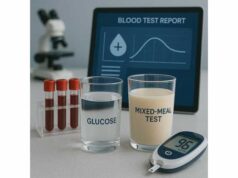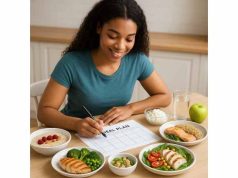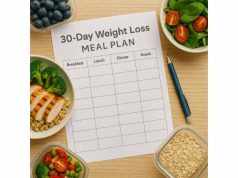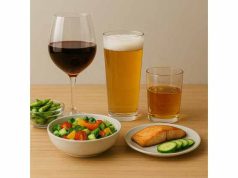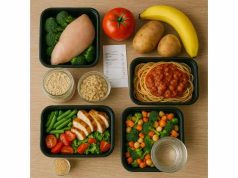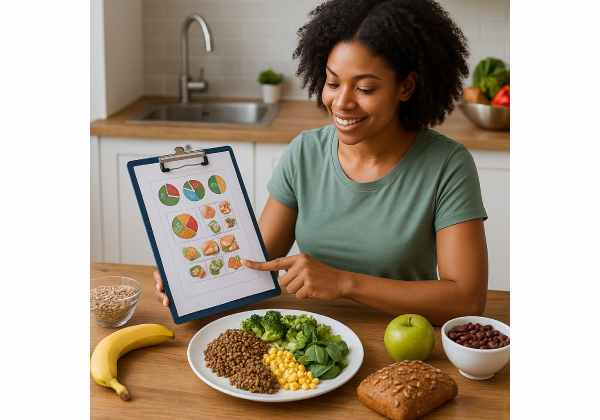
Most diets fail at the same point: hunger. Fiber helps because it adds volume, slows digestion, and steadies appetite while calories come down. The trick is not “eat more fiber,” but how much, from which foods, and how to increase it without bloating. This guide gives you practical daily targets, simple swaps, and ready-to-eat meal ideas that fit real life. If you still need to set your overall calories and macros, start with our concise overview of calorie budgeting and meal planning, then plug the fiber playbook below into your routine.
Table of Contents
- Fiber for weight loss basics
- How much fiber per day?
- Easy food swaps and lists
- Meals and sample day
- Common mistakes and fixes
- Safety, digestion and special cases
- What the evidence shows
- Frequently Asked Questions
Fiber for weight loss basics
Fiber is the part of plant foods your body does not fully digest. That is the point. It absorbs water, adds bulk, and slows the rate at which food leaves your stomach. The result is a larger plate for fewer calories and a steadier appetite between meals—two levers that make a calorie deficit easier to sustain.
Types of fiber (in plain language)
- Soluble, viscous fibers (oats, barley, beans, psyllium, apples, citrus) gel with water and slow gastric emptying. Meals feel more satisfying and blood sugar rises more gently.
- Insoluble fibers (wheat bran, many vegetables, skins of fruits and potatoes) add bulk and speed up transit. They are like scaffolding for digestion.
- Most plant foods contain both, so variety beats fixation.
Why fiber supports fat loss
- Volume without calories: vegetables, fruits, and legumes have fewer calories per gram. Bigger plates, same or lower energy intake.
- Hunger control: viscous fibers blunt rapid rises and dips in blood sugar that can drive cravings.
- Habit-friendly: when you structure meals around fiber and protein, you can stop micromanaging snacks because appetite becomes predictable.
Where fiber fits on the plate
- Anchor meals with protein (25–45 g), then add high-fiber plants until the plate looks full. Finish with measured fats for flavor.
- Think soup-salad-protein at lunch and protein-two-veg-carb at dinner.
A quick visual
- A dinner plate half-filled with roasted vegetables and salad, a palm of protein, a fist of starch (beans, potatoes, or whole grains), and sauces measured with teaspoons.
If you want a broader foundation for habits beyond fiber, review the essentials of safe weight loss fundamentals and then return to dial in the details here.
How much fiber per day?
There are two practical ways to set your target: by total grams per day or by grams per 1,000 calories. Use whichever you will remember on a busy week.
Simple daily targets
- Most women: 25–35 g/day
- Most men: 30–45 g/day
- A flexible rule: 14 g per 1,000 calories (e.g., 1,800 kcal → ~25 g; 2,400 kcal → ~34 g)
Why the range?
Appetite, body size, cooking style, and tolerance vary. Start low and increase by 5 g per week until you reach your comfortable ceiling. Pair higher fiber with more water and a daily walk to keep digestion smooth.
Per-meal checkpoints (easy mode)
- Breakfast: 8–12 g (oats or fruit plus seeds, or a high-fiber cereal with yogurt)
- Lunch: 8–12 g (big salad with beans or whole grains)
- Dinner: 8–12 g (vegetables plus potatoes, barley, or lentils)
- Snack: 3–6 g (fruit, popcorn, whole-grain crackers, edamame)
High-return fiber picks
- Viscous all-stars: oats, barley, psyllium, beans, lentils, apples, citrus, okra.
- Effortless adds: chia, flax, ground psyllium (¼–½ tsp at a time stirred into yogurt or oats), frozen vegetables, canned beans (rinsed).
What about low-carb or gluten-free?
You can still hit fiber targets with non-grain plants: berries, greens, zucchini, eggplant, mushrooms, avocado, chia, flax, hemp seeds, almonds, coconut flour baking, and legume pastas as tolerated.
For macro context while you set fiber, skim our quick look at macro ratios for fat loss and then come back to build menus that match your numbers.
Easy food swaps and lists
You do not have to overhaul your diet. Swap like for like and let grams add up quietly. Use the ideas below to raise fiber with minimal effort.
Breakfast swaps
- Flavored yogurt → plain Greek yogurt + 1 cup berries + 1 tbsp chia (+5–7 g)
- White toast → sprouted or whole-grain bread (+2–4 g per slice)
- Cereal puffs → high-fiber cereal (look for ≥8 g per serving) or oatmeal (+4–10 g)
Lunch swaps
- Chicken wrap with mayonnaise → whole-grain wrap with hummus and vegetables (+6–8 g)
- Side of chips → air-popped popcorn (3 cups ≈ +3–4 g) or carrot sticks with 2 tbsp hummus (+3–4 g)
- White rice bowl → half rice, half barley or quinoa, add ½ cup beans (+7–10 g)
Dinner swaps
- Refined pasta → whole-wheat or legume pasta, toss with vegetables (+5–8 g per serving)
- Mashed potatoes with butter → boiled potatoes with skins and Greek yogurt (+3–5 g)
- Low-veg stir-fry → double the vegetables and add edamame (+6–10 g)
Snack ideas (3–8 g each)
- Apple or pear with skin
- Edamame (1 cup)
- Cottage cheese with raspberries
- Whole-grain crackers with tuna
- Psyllium yogurt (200 g yogurt + ½ tsp psyllium), drink water afterward
High-fiber shopping list
- Produce: berries, apples, pears, oranges, citrus, leafy greens, broccoli, Brussels sprouts, cauliflower, carrots, zucchini, eggplant, onions, cabbage, sweet potatoes, white potatoes (skins on)
- Pantry: oats, barley, brown rice, quinoa, farro, whole-wheat pasta, lentils, chickpeas, black beans, kidney beans, canned tomatoes, low-sodium broth
- Boosters: chia, flax, psyllium, toasted wheat bran, almond meal, sunflower seeds, pumpkin seeds
To pair fiber with plate-filling strategies, see our guide to high-volume foods and combine it with the swaps above.
Meals and sample day
Use these plug-and-play ideas to hit your fiber target without tracking every gram. Adjust portions to your calories and protein needs.
High-fiber breakfasts (10–15 g)
- Protein oats: ½ cup oats cooked in milk, stir in a scoop of whey or soy; top with 1 cup berries and 1 tbsp chia.
- Yogurt crunch bowl: 200 g Greek yogurt, 1 cup kiwi and strawberries, 2 tbsp high-fiber cereal, 1 tsp flax.
- Savory eggs and greens: omelet with mushrooms, spinach, tomatoes; thin slice whole-grain toast; orange on the side.
High-fiber lunches (10–15 g)
- Big salad with beans: romaine, cabbage, peppers, tomatoes, cucumber, ½ cup chickpeas, 150 g chicken or tofu; 2 tsp olive oil and vinegar.
- Soup and wrap: lentil or minestrone soup; turkey or seitan wrap in a whole-grain tortilla with vegetables.
- Potato and tuna plate: two small boiled potatoes, tuna mixed with yogurt-dill, steamed green beans.
High-fiber dinners (12–18 g)
- Stir-fry: 300–400 g mixed vegetables, 1 cup edamame or 150–200 g shrimp or tofu, small scoop of brown rice; finish with 1–2 tsp sesame oil.
- Sheet-pan rainbow: salmon or tempeh with broccoli, Brussels sprouts, and onions; side of barley or quinoa.
- Pasta-plus-veg: whole-wheat or red-lentil pasta tossed with roasted peppers, zucchini, mushrooms; top with turkey meat sauce or white beans.
Smart snacks (3–8 g)
- Apple with 2 tbsp powdered peanut butter stirred into yogurt
- Air-popped popcorn (3–4 cups) with nutritional yeast
- Pear and a handful of edamame
- Whole-grain crackers with hummus
For ready-made dinners that check both protein and fiber boxes, browse these streamlined high-protein, high-fiber dinners and rotate your favorites.
Sample day (about 30–35 g fiber)
- Breakfast: protein oats with berries and chia (12 g)
- Lunch: big bean salad bowl (10–12 g)
- Snack: popcorn (4 g)
- Dinner: salmon, roasted Brussels sprouts, small baked potato with skin (8–10 g)
Common mistakes and fixes
Fiber only helps if you can digest it comfortably and keep eating this way on ordinary days. Use this checklist to stay consistent.
Jumping from 10 g to 35 g overnight
Increase by ~5 g per week. Mix cooked and raw vegetables. Add a daily walk and more water. If a food bloats you, try it cooked, blended in a soup, or switch to lower-FODMAP options (zucchini, carrots, bell peppers, spinach).
Forgetting protein and fat
Fiber provides volume, but protein controls hunger and fat adds satisfaction. Anchor meals with 25–45 g protein and add measured fats (teaspoons, not pours).
Relying on “diet snacks”
Fiber bars can help in a pinch but often bring sugar alcohols that upset stomachs. Prefer fruit, popcorn, yogurt, hummus with vegetables, or edamame.
Dry fiber supplements without water
If you use psyllium, stir it into yogurt or oats, or drink a full glass of water afterward. Start with ¼–½ teaspoon once daily.
Restaurant drift
Dressings and oils add fast calories. Ask for sauces on the side, swap fries for vegetables or a side salad, and order beans or greens as an extra side.
If stalling is the issue, skim these quick fixes for common dieting errors and then adjust your week.
Safety, digestion and special cases
Fiber is safe and helpful for most adults, but context matters. Tailor the plan to your digestion, medical needs, and goals.
Sensitive digestion or IBS
Some fibers ferment quickly and cause gas. Try lower-FODMAP vegetables (zucchini, carrots, spinach, bell peppers), canned and well-rinsed lentils, firm tofu, and oats. Increase gradually and favor cooked preparations and blended soups.
Diabetes or glucose concerns
Fiber is your friend—especially viscous sources like oats, barley, beans, psyllium, apples, and citrus. Pair carbs with protein and monitor responses as you change your routine.
Athletes and heavy training
Keep fiber higher away from workouts. Eat lower-fiber carbs (rice, potatoes, ripe bananas, yogurt) before and after sessions; load vegetables and legumes at other meals.
Medications
Fiber can alter absorption when taken simultaneously with certain medications or supplements. Separate by 2–4 hours unless your clinician advises otherwise.
Hydration
As fiber increases, so should fluids. Aim to drink regularly through the day and include hydrating foods. For simple, practical ideas, review these hydration strategies and make a plan that fits your routine.
Supplements vs food
Food should do most of the work. If you supplement, start small: ¼–½ tsp psyllium once daily, then increase as tolerated. Mix with yogurt or oats to improve comfort.
What the evidence shows
The weight loss benefit of fiber is not magic; it is mechanics plus behavior.
Mechanics
- Volume and viscosity: viscous fibers thicken in the stomach, slow gastric emptying, and promote fullness.
- Energy density: plants carry water and fiber, lowering calories per gram so plates look generous.
- Glycemic smoothing: slower glucose rise reduces rebound hunger.
Behavior
- Bigger bowls and plates mean fewer snacks later.
- Structured meals (protein plus fiber, 2–4 times daily) reduce grazing and decision fatigue.
- Sustainability: when meals feel normal and satisfying, adherence improves—and adherence drives results.
Realistic timelines
- Week 1–2: appetite steadies as you swap refined foods for high-fiber plants and adjust hydration.
- Week 3–8: steady fat loss is common when fiber is paired with an appropriate calorie target, protein floor, and basic movement.
- Beyond 8 weeks: plateaus happen—recheck portions of oils, nuts, cheese, desserts, and restaurant meals; keep steps up; adjust fiber sources for comfort.
Bottom line
Fiber is a force multiplier. It makes eating less feel like eating plenty, especially when combined with adequate protein and measured fats. Start with small swaps, add a little each week, and let your routine do the work.
Frequently Asked Questions
How much fiber per day helps with weight loss?
Most adults do well with 25–45 grams per day or 14 grams per 1,000 calories. Start on the lower end and increase by about 5 grams per week to reduce bloating. Distribute fiber across two to four meals and drink water regularly.
What is the difference between soluble and insoluble fiber?
Soluble, viscous fiber (oats, barley, beans, psyllium, apples) gels with water, slowing digestion and improving fullness. Insoluble fiber (bran, many vegetables, potato skins) adds bulk and speeds transit. Most plants contain both, so variety is the simplest strategy.
Can fiber supplements help me lose weight?
They can help you reach your daily total and improve satiety, especially psyllium. Start with ¼–½ teaspoon mixed into yogurt or oats, then increase as tolerated. Supplements support food choices, but whole foods should do most of the work.
I get bloated when I eat more vegetables. What should I change?
Increase fiber gradually, cook vegetables instead of eating them raw, and try lower-FODMAP options like zucchini, carrots, and spinach. Rinse canned beans well, start with ½ cup, and add a daily walk and water to improve comfort.
Do I need grains to meet my fiber goal?
No. You can hit targets with vegetables, fruits, legumes, potatoes with skins, nuts, and seeds. Grains are convenient, but not mandatory. If you include them, choose oats, barley, whole-wheat, or legume pasta for more fiber per serving.
Does fiber block nutrient absorption?
Very high fiber right with supplements or medications can interfere with absorption. Separate fiber supplements from medications by 2–4 hours. From whole foods, this is rarely a practical issue if your diet includes a variety of plants and proteins.
References
- Psyllium is a natural nonfermented gel-forming fiber that is effective for weight loss: A comprehensive review and meta-analysis 2023 (Systematic Review & Meta-analysis)
- Effects of Four Different Dietary Fibre Supplements on Weight Loss and Lipid and Glucose Serum Profiles during Energy Restriction in Patients with Traits of Metabolic Syndrome: A Comparative, Randomized, Placebo-Controlled Study 2023 (RCT)
- The Effects of Soluble Dietary Fibers on Glycemic Response: An Overview and Futures Perspectives 2022 (Review)
- 7 Dietary, Functional, and Total Fiber | Dietary Reference Intakes for Energy, Carbohydrate, Fiber, Fat, Fatty Acids, Cholesterol, Protein, and Amino Acids | The National Academies Press 2005 (Guideline / Seminal)
Disclaimer
This article provides general education and is not a substitute for personalized medical advice, diagnosis, or treatment. Speak with your healthcare professional before changing your diet—especially if you have gastrointestinal disorders, diabetes, kidney or liver disease, are pregnant or breastfeeding, or have a history of disordered eating.
Share and follow
If this guide helped you hit a realistic fiber target, please share it with a friend who wants bigger, more satisfying meals while losing weight. For new practical articles and templates, follow us on the social platform you use most—Facebook, X, or another network you prefer.

